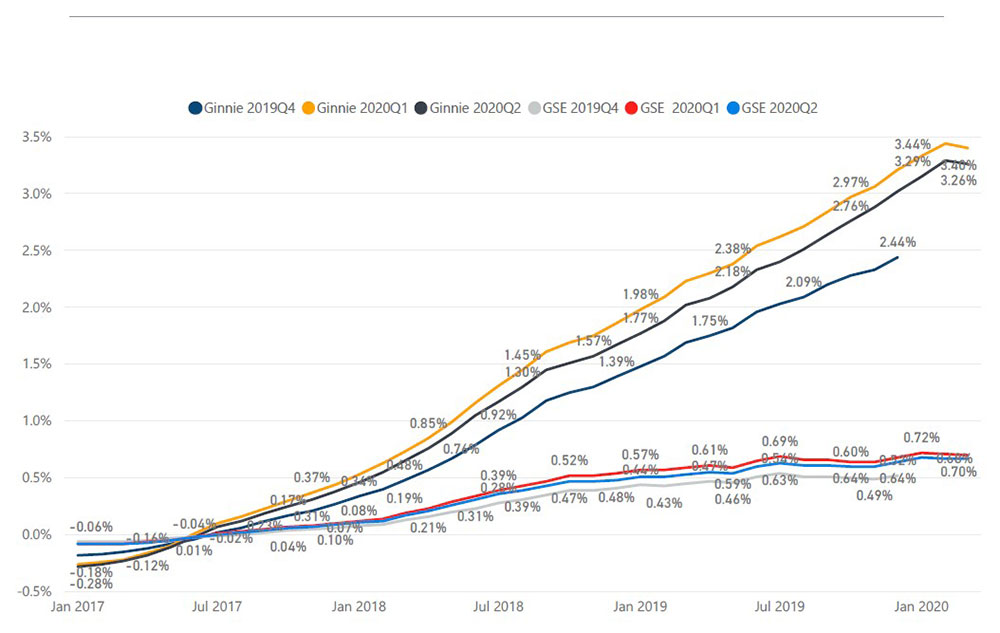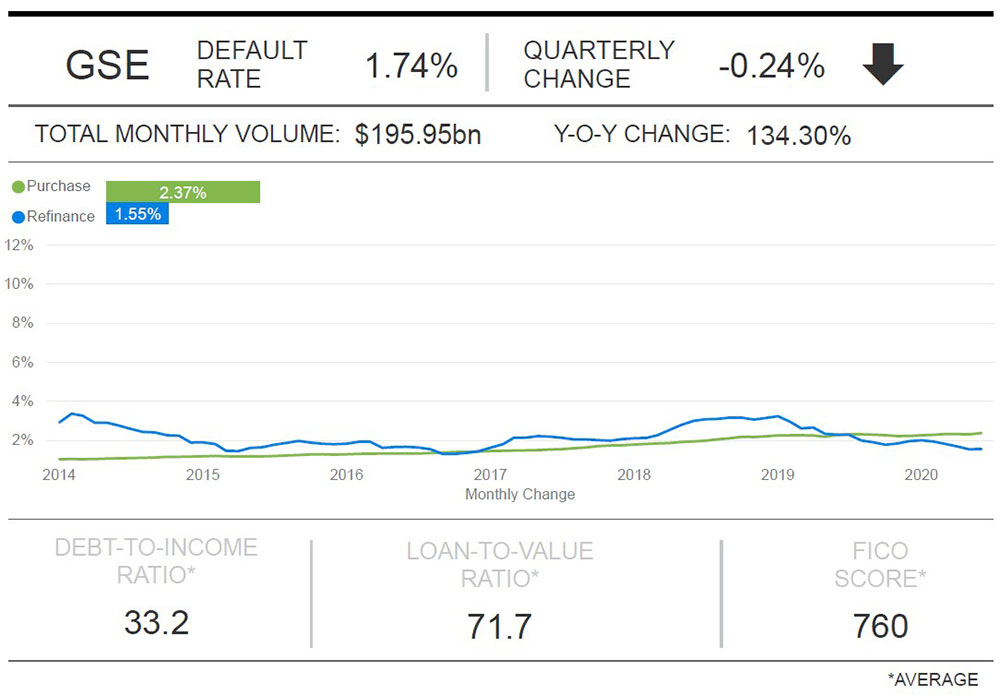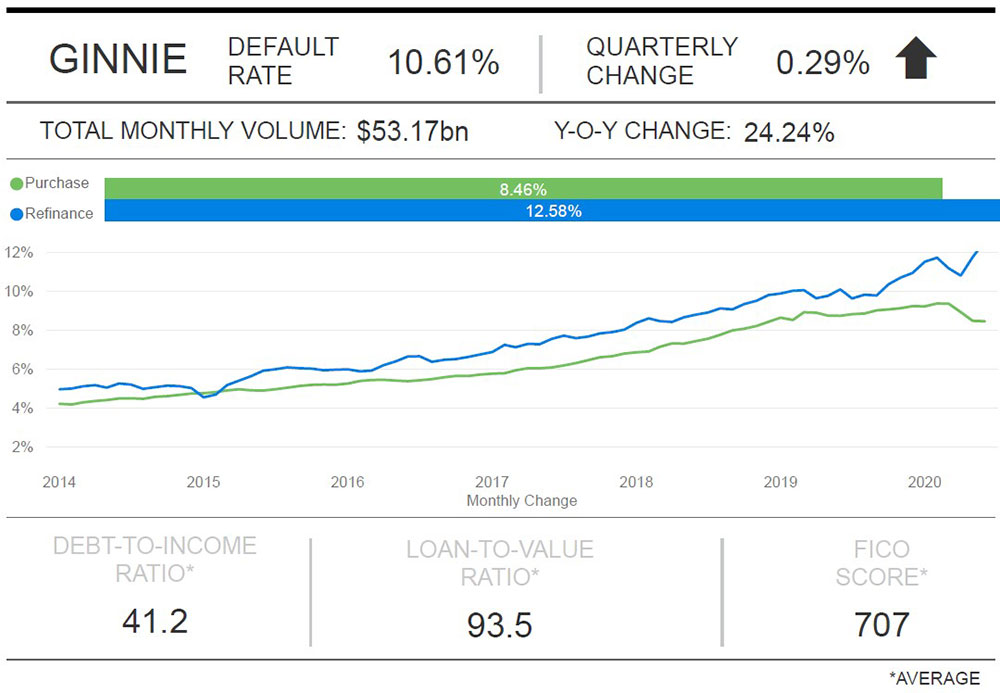The Milliman Mortgage Default Index (MMDI) is a lifetime default rate estimate calculated at the loan level for a portfolio of single-family mortgages. For the purposes of this index, default is defined as a loan that becomes 180 days delinquent or worse.1 The results of the MMDI reflect the most recent data acquisition available from Freddie Mac, Fannie Mae, and Ginnie Mae, with measurement dates starting from January 1, 2014.
COVID-19 effects on mortgage risk
Interact with the MMDI
To explore the MMDI data on a more granular level, including loan origination and type, click here.
There is significant uncertainty regarding how COVID-19 and its associated economic impacts may affect mortgage performance. While unemployment rates, delinquency rates, and the percent of loans in forbearance have increased rapidly since the start of the pandemic, the housing market has remained surprisingly resilient. Recent articles published by Milliman provide a more detailed analysis, including:
- COVID-19’s impact on regional housing markets, including interactive dashboards
- An overarching look at the impact of the pandemic on the mortgage market
- How the upcoming refinance fee (initiated to help cover the costs of the pandemic) affects mortgage borrowers
The models used in Milliman’s MMDI analysis rely upon home prices to forecast default rates; they do not rely on unemployment rates nor do they have specific adjustments for special forbearance programs such as those introduced in the CARES Act, which could result in an increase in forbearance and delinquency rates. Given this, the MMDI results for 2020 Q2 may underestimate the ultimate number of delinquencies that occur as a result of the COVID-19 pandemic. Adjustments have not been added to the models in response to COVID-19 because the models and index are designed to identify long-term trends on mortgage credit consistently across time.
Historically, the transition rate from delinquency to claim has been driven by borrower equity. Given the robust home price growth experienced over the past several years and now during the pandemic, many delinquent borrowers are expected to cure from these delinquency events as they have equity in their properties. Milliman is actively monitoring and analyzing these trends to evaluate future mortgage performance in light of COVID-19.
Key findings: 2020 Q2
The last issue of the MMDI focused on a deteriorating economic forecast as a result of the pandemic. We anticipated that the pandemic would result in both a decrease in economic activity and the demand for homeowners to move or buy a home. Contrary to initial expectations, demand for housing has increased (as evidenced by greater purchase volume), and the supply of housing has decreased. This has resulted in robust increases in home values. One of the drivers of the MMDI is home prices, which is measured as “economic risk” in our index.
Figure 1 shows the economic risk component of the MMDI for Ginnie Mae mortgages and GSE mortgages between 2019 Q4 and 2020 Q2. From 2019 Q4 to 2020 Q1, economic risk increased as a result of the pandemic and anticipated negative impact on home prices. However, home price growth continued its upward trend, resulting in a decrease in economic risk in the MMDI for 2020 Q2.
FIGURE 1: ECONOMIC RISK BY INVESTOR AND ORIGINATION

When reviewing the trend in overall default risk, the MMDI for GSE acquisitions (loans acquired by Freddie Mac and Fannie Mae) decreased from 1.99% for loans originating in 2020 Q1 to 1.74% for loans originating in 2020 Q2. This is because, as interest rates continued to decline, lower default risk from refinance loans offset an increase in default risk for purchase loans. Figure 2 provides the quarter-end index results for these loans segmented by purchase and refinance.
The MMDI for Ginnie Mae loans increased from 10.33% in 2020 Q1 to 10.61% in 2020 Q2 as can be seen in Figure 3 (segmented by purchase and refinance). For certain types of refinance loans (e.g., streamline refinance loans), Ginnie Mae acquisitions do not receive an updated credit score. For the MMDI, a credit score of 600 is conservatively used to calculate the default risk on mortgages with a missing credit score. Because a large portion of volume was refinance volume, many Ginnie Mae loans are getting assigned a fairly low credit score.
FIGURE 2: MMDI 2020 Q2 DASHBOARD FOR GSE LOANS

FIGURE 3: MMDI 2020 Q2 DASHBOARD FOR GINNIE LOANS

Agency summary
When comparing the most recent Freddie and Fannie acquisitions to the prior quarter, we see the continued trend of decreased borrower and underwriting risk profiles. This is because recent volume has been heavily weighted towards refinance loans resulting from declines in interest rates.
For the most recent quarter, approximately 70% of the mortgage volume was refinance loans. To put this in context, the amount of refinance volume in 2020 to-date has exceeded $1 trillion and is greater than the sum of total refinance volume in 2018 and 2019 combined. Refinance loans tend to have lower loan-to-value (LTV) ratios and lower risk relative to purchase loans. This combined with home price growth resulted in a decline in the MMDI from 1.99% to 1.74%.
Components of default risk
The components of the MMDI that inform default risk are borrower risk, underwriting risk, and economic risk. Borrower risk measures the risk of the loan defaulting due to borrower credit quality, initial equity position, and debt-to-income ratio. Underwriting risk measures the risk of the loan defaulting due to mortgage product features such as amortization type, occupancy status, and others. Economic risk measures the risk of the loan defaulting due to historical and forecasted economic conditions.
BORROWER RISK RESULTS: 2020 Q2
For GSE loans, borrower risk decreased in 2020 Q2 relative to 2020 Q1 from an average of 1.31% to 1.12%. The decrease is largely attributable to a significant increase in refinance volume. In addition, several originators initiated credit overlays to manage risk during the pandemic. These overlays required higher minimum credit scores, larger down payments, or lower debt-to-income ratios. For Ginnie Mae loans, borrower risk similarly decreased in 2020 Q2 relative to 2020 Q1 from an average of 6.65% to 6.40%. However, the reduction in borrower risk came from a decrease in risk on purchase loans, falling from an average of 6.20% in 2020 Q1 to 5.59% in 2020 Q2. As Ginnie Mae loans are generally lower credit score/higher loan-to-value ratio loans, the originator-imposed credit overlays had a larger impact on Ginnie Mae loans relative to GSE loans. For Ginnie Mae refinance loans, the borrower risk component of the MMDI increased slightly quarter-to-quarter.
Loans guaranteed by Ginnie Mae experienced an increase in their default risk in 2020 Q2 driven mainly by increased refinance volume. Of the Ginnie Mae loans originated during this time period, 50% were refinance loans. Many refinance loans were originated through streamlined refinance programs, where a credit score is not provided. These loans are conservatively assigned a credit score of 600 in the index, which increases borrower default risk during heavy refinance periods for Federal Housing Administration and Veterans Affairs mortgages. We note that the MMDI for purchase loans decreased for 2020 Q2 originations relative to 2020 Q1 originations. For the most recent quarter, the MMDI value for borrower risk (measured by FICO/ LTV/DTI) was 5.41%, compared to 6.81% as of March 2019. The downward trend indicates a stronger borrower risk profile for more recent purchase FHA loans relative to 2019 originations.
UNDERWRITING RISK RESULTS: 2020 Q2
Underwriting risk represents additional risk adjustments for property and loan characteristics such as occupancy status, amortization type, documentation types, loan term, and others. Underwriting risk after the global financial crisis remains low and is negative for purchase mortgages, which were generally full documentation, fully amortizing loans. In 2020 Q2, we have seen an increase in the percentage of refinance loans that are rate/term. This loan type has a lower risk profile relative to cash-out refinance mortgages.
ECONOMIC RISK RESULTS: 2020 Q2
Economic risk is measured by looking at historic and forecasted home prices. Actual home price appreciation has been robust from 2014 through 2020, which has resulted in embedded appreciation for older originations. This results in reduced credit risk for older cohorts. For more recent cohorts, we continue to anticipate slower home price growth (or negative growth for some local geographies), which contributes to increases in economic risk for recent origination years. Please read the disclaimer for COVID-19 for more context on economic risk.
For more detail on the MMDI components of risk, visit milliman.com/MMDI.
About the Milliman Mortgage Default Index
Milliman is an expert in analyzing complex data and building econometric models that are transparent, intuitive, and informative. We have used our expertise to assist multiple clients in developing econometric models for evaluating mortgage risk both at point of sale and for seasoned mortgages.
The Milliman Mortgage Default Index (MMDI) uses econometric modeling to develop a dynamic model that is used by clients in multiple ways including analyzing, monitoring, and ranking the credit quality of new production, allocating servicing sources, and developing underwriting guidelines and pricing. Because the MMDI produces a lifetime default rate estimate at the loan-level, it is used by clients as a benchmarking tool in origination and servicing. The MMDI is constructed by combining three important components of mortgage risk: borrower credit quality, underwriting characteristics of the mortgage, and the economic environment presented to the mortgage. The MMDI uses a robust dataset of over 30 million mortgage loans, which is updated frequently to ensure it maintains the highest level of accuracy.
Milliman is one of the largest independent consulting firms in the world and has pioneered strategies, tools, and solutions worldwide. We are recognized leaders in the markets we serve. Milliman insight reaches across global boundaries, offering specialized consulting services in mortgage banking, employee benefits, healthcare, life insurance and financial services, and property and casualty insurance. Within these, Milliman consultants serve a wide range of current and emerging markets. Clients know they can depend on us as industry experts, trusted advisers, and creative problem-solvers. Milliman's Mortgage Practice in Milwaukee is dedicated to providing strategic, quantitative, and other consulting services to leading organizations in the mortgage banking industry. Past and current clients include many of the nation's largest banks, private mortgage guaranty insurers, financial guaranty insurers, institutional investors, and governmental organizations.
For more information and access to the loan-level detail, including seller, geographic, and channel break-outs, please reach out to Milliman.
1For example, if the MMDI is 10%, then we expect 10% of the mortgages originated in that month to have become 180 days delinquent or worse over its lifetime.